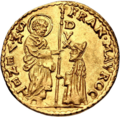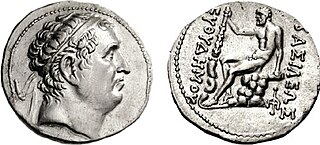
Euthydemus Ic. 260 BC – 200/195 BC) was a Greco-Bactrian king and founder of the Euthydemid dynasty. He is thought to have originally been a satrap of Sogdia, who usurped power from Diodotus II in 224 BC. Literary sources, notably Polybius, record how he and his son Demetrius resisted an invasion by the Seleucid king Antiochus III from 209 to 206 BC. Euthydemus expanded the Bactrian territory into Sogdia, constructed several fortresses, including the Derbent Wall in the Iron Gate, and issued a very substantial coinage.

The Sanctuary of Saint Michael the Archangel is a Roman Catholic shrine on Mount Gargano, Italy, part of the commune of Monte Sant'Angelo, in the province of Foggia, northern Apulia. It has the dignity of a minor basilica.
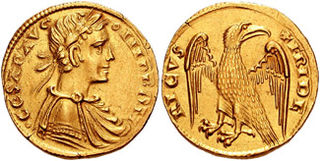
An augustalis or augustale, also agostaro, was a gold coin minted in the Kingdom of Sicily beginning in 1231.

The Duchy of Benevento was the southernmost Lombard duchy in the Italian Peninsula that was centred on Benevento, a city in Southern Italy. Lombard dukes ruled Benevento from 571 to 1077, when it was conquered by the Normans for four years before it was given to the Pope. Being cut off from the rest of the Lombard possessions by the papal Duchy of Rome, Benevento was practically independent from the start. Only during the reigns of Grimoald and the kings from Liutprand on was the duchy closely tied to the Kingdom of the Lombards. After the fall of the kingdom in 774, the duchy became the sole Lombard territory which continued to exist as a rump state, maintaining its de facto independence for nearly 300 years, although it was divided after 849. Benevento dwindled in size in the early 11th century, and was completely captured by the Norman Robert Guiscard in 1053.
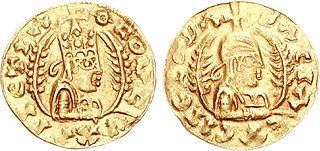
Nezool was a king of the Kingdom of Aksum. He is primarily known from the coins minted during his reign, where his name also appears as Nezana.

Arechis II was a Duke of Benevento, in Southern Italy. He sought to expand the Beneventos' influence into areas of Italy that were still under Byzantine control, but he also had to defend against Charlemagne, who had conquered northern Italy.

Adelchis was the son of Radelchis I, Prince of Benevento, and successor of his brother Radelgar in 854.

Medieval Bulgarian coinage were the coins minted by the Bulgarian Emperors during the Middle Ages at the time of the Second Bulgarian Empire.
Manso was a Lombard viceduke (vicedux) who ruled the Duchy of Amalfi during the reign of Roger Borsa, the Norman Duke of Apulia. He is known only from his coins: large, copper follari bearing the inscription MANSO VICEDUX on the reverse. Irregular and poor in quality, mostly overstrikes of Salernitan coins, they were originally attributed to Manso of Salerno (981–83).
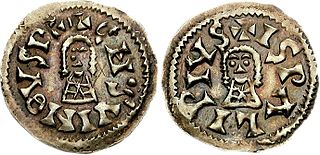
The coinage of the Visigoths was minted in Gaul and Hispania during the early Middle Ages, between the fifth century and approximately 710.
The English shilling was a silver coin of the Kingdom of England, when first introduced known as the testoon. A shilling was worth twelve pence, and there were 20 shillings to the pound sterling. The English shilling was introduced in the 16th century and remained in circulation until it became the British shilling as the result of the Union of England and Scotland to form the Kingdom of Great Britain in 1707.

Sasanian Iberia refers to the period the Kingdom of Iberia was under the suzerainty of the Sasanian Empire. The period includes when it was ruled by Marzbans (governors) appointed by the Sasanid Iranian king, and later through the Principality of Iberia.

Signum manus refers to the medieval European practice of signing a document or charter with a special type of monogram or royal cypher. The practice is documented from at least the Merovingian period until the 14th century in the Frankish Empire and its successors.
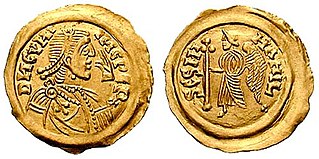
The coinage of the Lombards refers to the autonomous productions of coins by the Lombards. It constitutes part of the coinage produced by Germanic peoples occupying the former territory of the Roman Empire during the Migration Period. All known Lombard coinage was produced after their settlement of Italy. The coinage originates from two distinct areas, in Langobardia Major between the last decades of the sixth century and 774, and in Langobardia Minor, in the duchy of Benevento, between approximately 680 and the end of the 9th century.
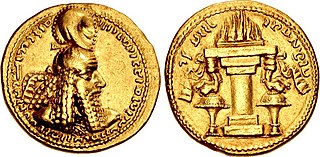
Sasanian coinage was produced within the domains of the Iranian Sasanian Empire (224–651). Together with the Roman Empire, the Sasanian Empire was the most important money-issuing polity in Late Antiquity. Sasanian coinage had a significant influence on coinage of other polities. Sasanian coins are a pivotal primary source for the study of the Sasanian period, and of major importance in history and art history in general. The Sylloge nummorum Sasanidarum is the most important primary work of reference for Sasanian coins.

The siege of Salerno was one of the campaigns of the Aghlabids in southern Italy during their conquest of Sicily. The Lombard city of Salerno had strong defences and, despite the use of stone-throwing artillery, the siege lasted a little over a year from its beginning in late 871 or early 872. Prince Guaifer of Salerno led the defence, but the siege was only lifted by the arrival of an army of Lombards and Franks under the Emperor Louis II.
The coinage of Suessa concerns coins minted in Suessa, a city in ancient Campania inhabited by the Aurunci, an ancient Italic population. The city minted coins in the period between 268 B.C. and the Second Punic War.

The coinage of Capua concerns coins minted in ancient Capua, a city in ancient Campania, corresponding to present-day Santa Maria Capua Vetere. The city was located on the Appian Way and was the most important in the area, probably the largest center in the Italian peninsula after Rome.

The coinage of Cales concerns coins minted in Cales, a city in Campania, the most important urban center of the ancient Italic population of the Ausones. Cales was located on the Via Latina, halfway between the mountains of Samnium and the plains of Campania felix, a few kilometers north of Casilinum and just south of Teanum Sidicinum.

The Lombard coinage of Benevento, part of the more general Lombard coinage, is the set of coins minted between about 680 and the end of the ninth century in the duchy and principality of Benevento. Solidi and tremisses, both gold coins that imitated those of the Eastern Roman Empire, were first minted; later followed the issuance of coins in the names first of the dukes and then of the Benevento princes. Toward the end of the 8th century alongside the gold coins were minted silver coins, which gradually took the place of the earlier ones, as moreover happened in the rest of Western Europe. Silver became the prevalent coinage metal only from the mid-9th century.
































